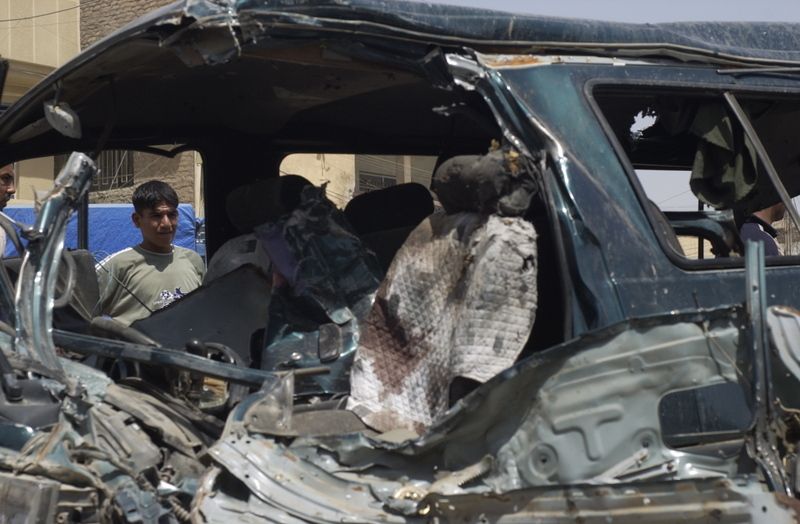David Enders, for the Pulitzer Center
Photo of minibus in July 2007, which according to Baghdad residents was fired on by a US military helicopter the previous day.
Yesterday, Democracy Now ran interviews Rick Rowley and I did with Iraqis in July 2007 in Baghdad's Al Amin al Ithania neighborhood following the killing of about a dozen people, including two Reuters journalists.
The scene was tense and we were not allowed to film at the funerals of the victims. We had actually come to Amin al Ithaniya looking for refugees from the provinces around Baghdad, but residents there insisted on relating the events of the previous day. Being guests in the neighborhood, we obliged, engaging in what we refer to as "being polite" - doing interviews that have nothing to do with the story we are working on to demonstrate that we are willing to listen to people's concerns. It helps win trust, especially when it's easy for people to see you as the stand-in for the guys who shot up the place the day before. It's not that I didn't care about what had happened, it's that it's not an uncommon scenario - US military accounts of engagements rarely match those of Iraqi witnesses, and the self-reporting that takes place (number of killed, wounded, combatants vs. noncombatants) does not appear to be very scientific. I've been on more than a few goose chases trying to track down the particulars of similar events over the years, and while it's often hard to prove anything conclusive, it's made me very, very skeptical of many of the claims the US military makes.
The military's assertion that non-combatants had not been killed in the engagement was immediately questionable - three of the men killed that day were Christians. It is highly unlikely they were members of the Jeish al Mehdi, the (Shiite) militia loyal to Moqtada Sadr that at the time controlled the neighborhood and much of Baghdad.
By the logic used to kill the non-combatants seen dying in this video, everyone in eastern Baghdad or any other neighborhood controlled by a militia hostile to the US was a combatant at that point. Were there Sadr militiamen on that street with the two Reuters journalists? I'm sure. Had the journalists been in a Sunni neighborhood, there might have been armed US-backed militiamen patrolling the same way. Did members of the militia come to check us out while we were reporting the following day? Of course they did. In fact, simply to gain safe entry to the neighborhood we were in direct contact with members of the militia's press office, one of whom frequently accompanied us on reporting trips to make sure that if anything happened to us while in the neighborhood, the militia was aware of our presence and that it had been approved by Sadr's press office. Does that mean I could have been strafed?
Whether you think this is cold-blooded murder or simply a bad choice by a journalist, the most important thing for Americans to do is to watch. This is the war that goes on, but it is not the war we see or hear. Listen to the voices of those soldiers, mowing people down like it's a video game, hoping the wounded will walk so they can shoot them again. I wish I could say language like this is rare from American soldiers, but I have heard it (and worse) before.
If you wonder why Iraqis are angry, look no further for your answer.
By the way, today is April 9. It's been 7 years since Baghdad officially "fell" to US troops.
Editor's note: Earlier this week, Wikileaks.org posted the video from July 2007 showing a U.S. military helicopter opening fire and killing people in a Baghdad street, including Reuters photographer, Namir Noor-Eldeen, 22, and driver, Saeed Chmagh, 40.
